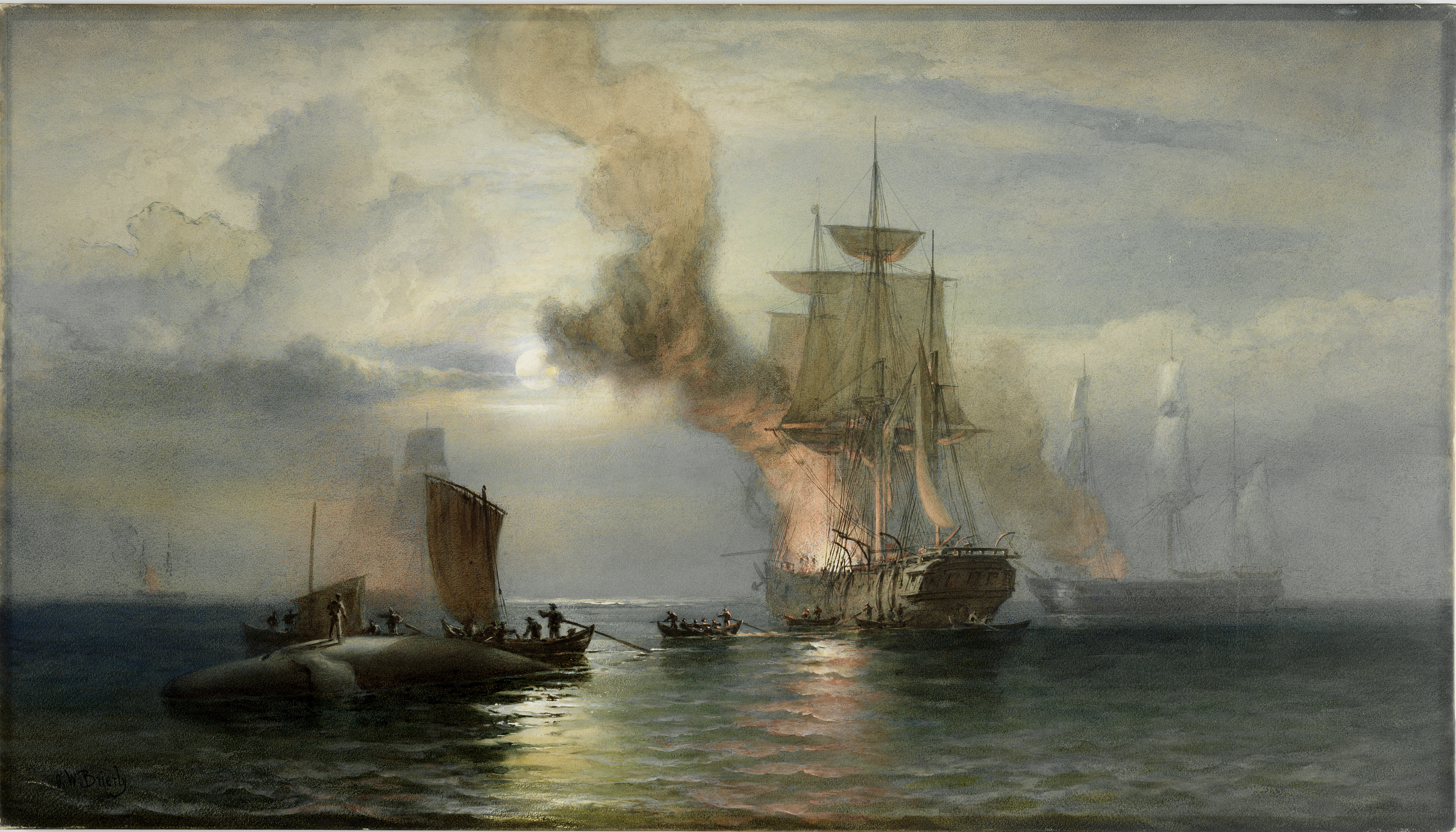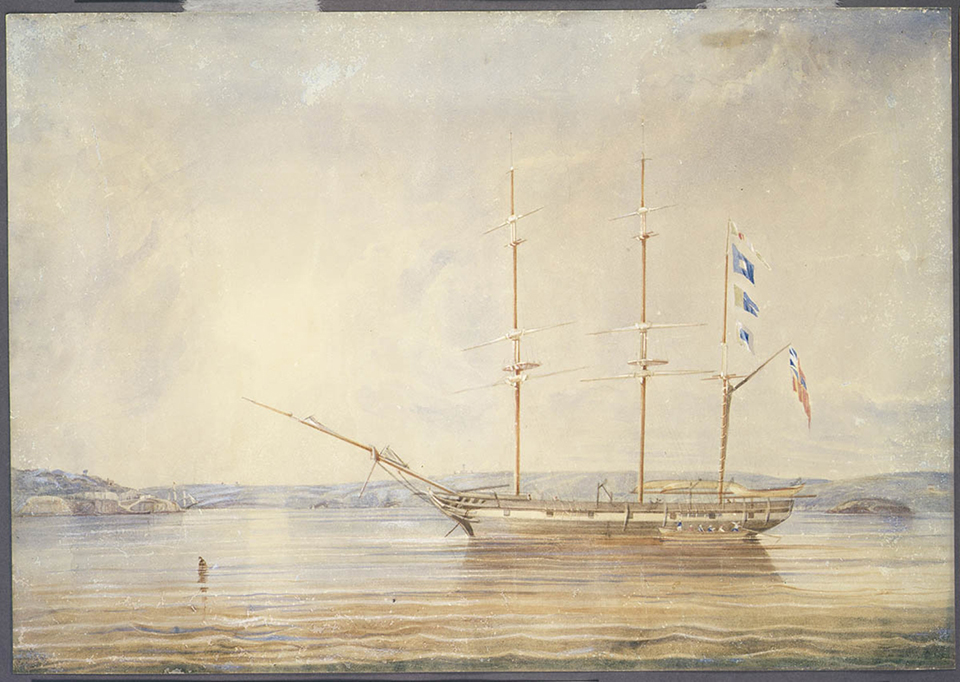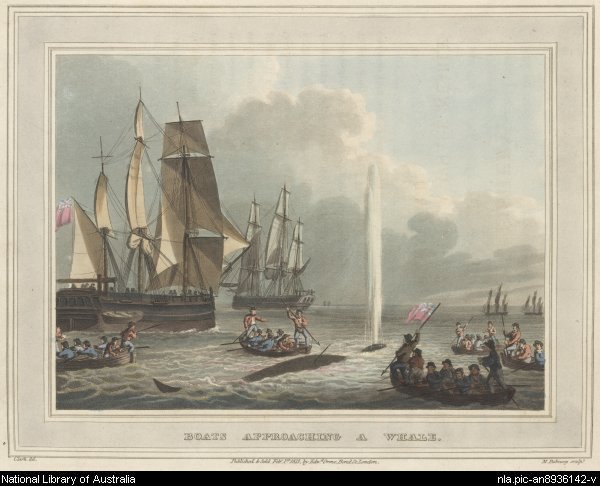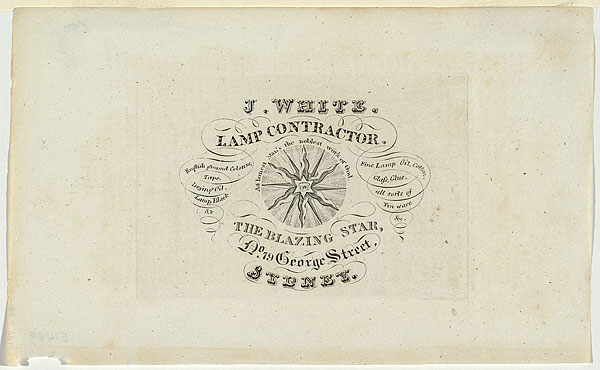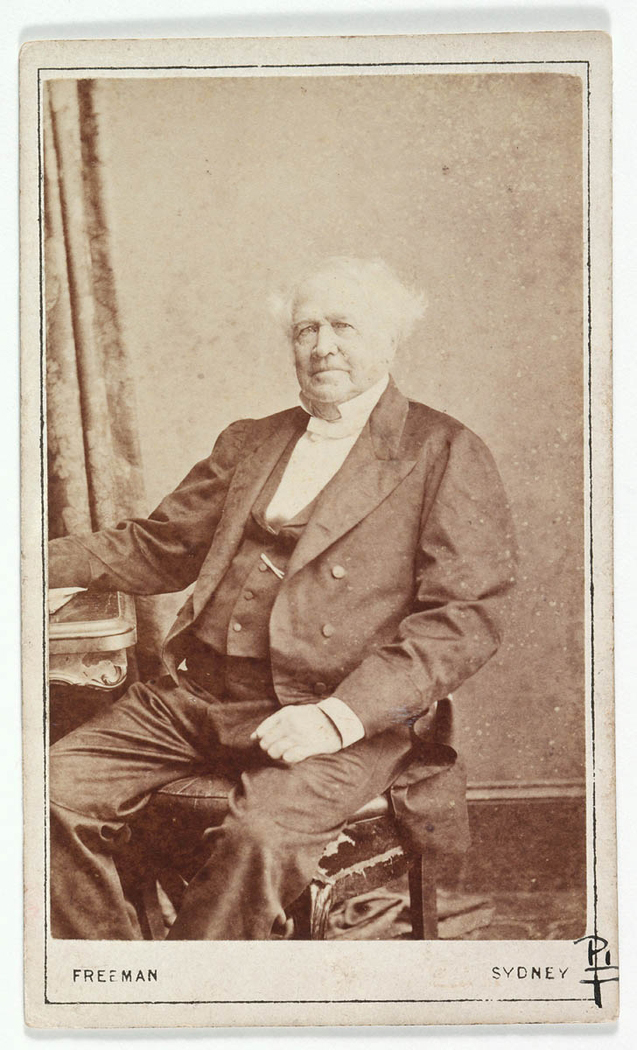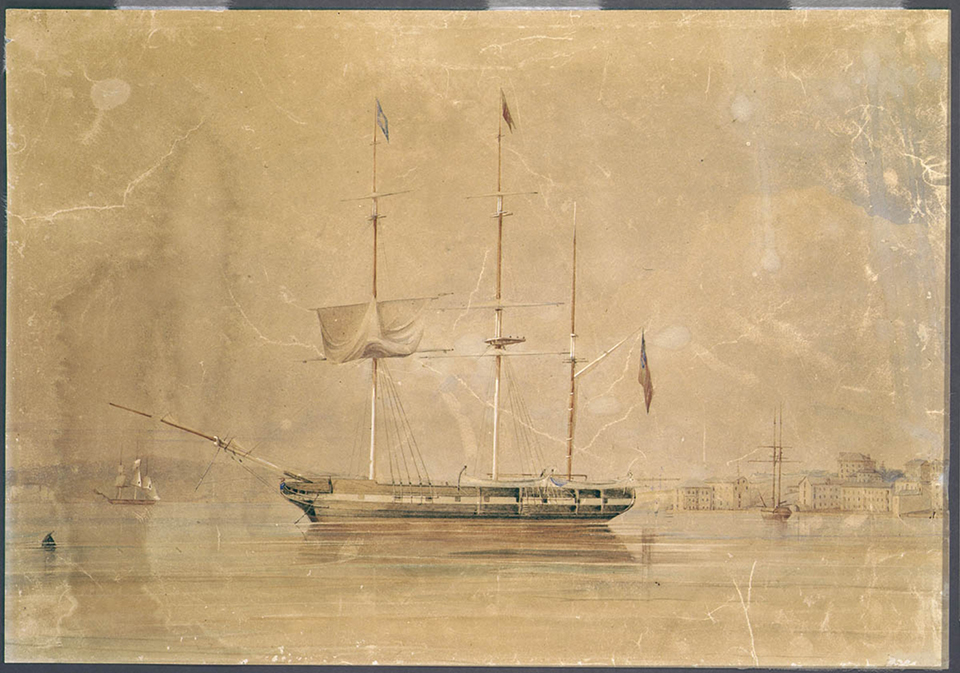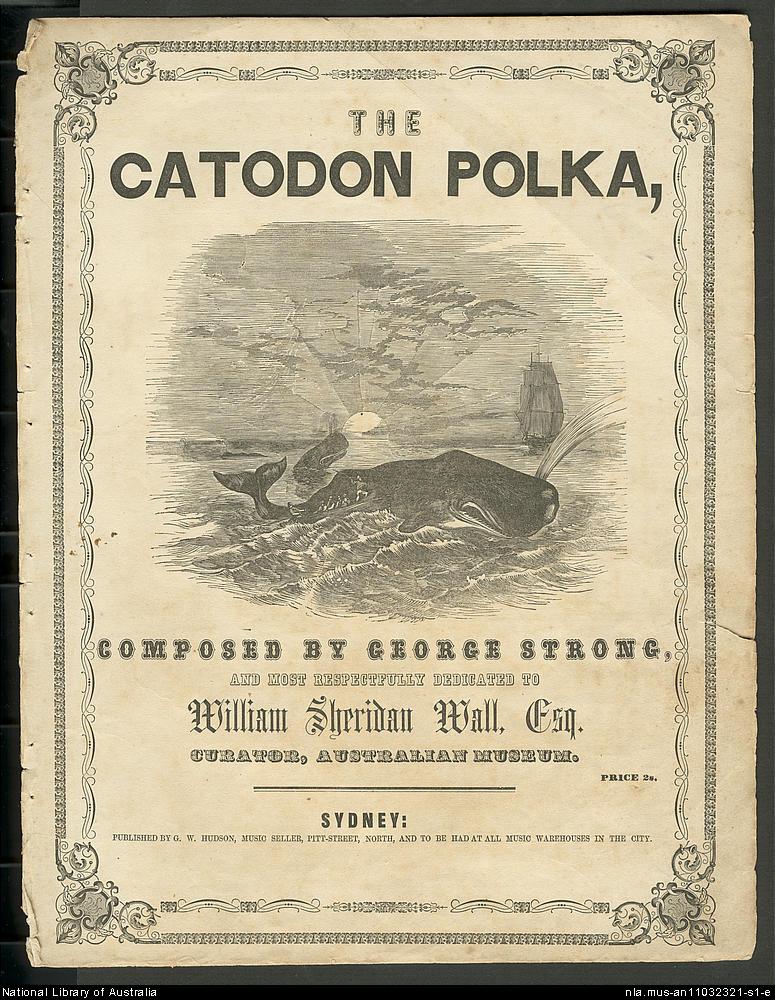The Dictionary of Sydney was archived in 2021.
Sydney's whaling fleet
Citation
Persistent URL for this entry
To cite this entry in text
To cite this entry in a Wikipedia footnote citation
To cite this entry as a Wikipedia External link
Sydney's whaling fleet
The [media]whaling trade was a major industry in Australia during the nineteenth century employing hundreds of ships and thousands of men and providing the colonies with export commodities worth £4.2 million by 1850. [1] Sydney was the main Australian whaling port with a fleet that produced whale oil and baleen valued at £2.6 million between 1825 and 1879. [2]
Whaling moreover was an activity that had a number of advantages over the wool industry that developed at the same time. It took years of careful breeding and slow natural increase of sheep flocks before wool production became paramount. But whale numbers were at their maximum from the very start. The wool clip was gathered only once a year, but whales could be taken by deep-sea whalers all the year round.
British South Sea whaling
British South Sea whaling had its origins in the American War of Independence, which began in 1776. The conflict had a number of commercial consequences, one of which was disruption in American sperm whale oil exports to the United Kingdom. The oil was important as a machine lubricant for the Industrial Revolution then underway in Britain. [3] It was also employed as a high quality lamp fuel, as it burnt with a bright clear light and left no smell. Although Britain continued to receive oil from her Arctic whaling fleet, the 'black' oil from the northern right whale had fewer uses and was worth only half as much.
To get the sperm whale oil needed for her economy, Britain began to send her own vessels into the south Atlantic. They were commanded at first by expatriate American captains, with other Americans aboard to teach the British seamen the dangerous task of capturing the more active and aggressive sperm whale. The government was keen to see the fishery flourish and provided bounties and other forms of assistance to help the trade develop.
The war ended in 1783 and sperm whale oil exports resumed from the United States. But British southern whalers were reluctant to relinquish the profits of the trade to their American rivals and so British involvement in the fishery continued and grew in scale. A feverish enthusiasm for South Sea whaling developed in London and led one contemporary to remark in 1785 that,
The spirit of whaling seems almost run to a degree of madness; they intend if men can be got to send out 30 ships, but at present there appears no possibility of getting men. [4]
Into the Pacific
A new era of expansion began in 1788 when the London whaler Emelia rounded Cape Horn and entered the Pacific Ocean, returning home two years later with a full cargo of sperm whale oil. [5] By the time she was ready to sail again, 10 other London whalers were preparing to follow her into a region whose whaling potential seemed as vast as the Pacific Ocean itself. [6]
The first Pacific whaling ground to be exploited was off the coast of Peru. Sperm whales were plentiful there and supplies could be obtained at Spanish colonial ports on the coast of South America. However the outbreak of war with Spain in 1797 closed these ports to British whalers and Spanish warships began to harass and capture such vessels found offshore. Suddenly, Sydney, on the other side of the Pacific, started to look attractive as a base for British whalers.
British whalers at Port Jackson
Even [media]before the outbreak of hostilities with Spain, British whalers and sealers had started to visit Sydney. Indeed, they were the most frequent visitors to Port Jackson during the first decade of settlement. As well as those that came independently, at least one third of the convict transports and store ships sent by the government before 1800 were British whalers under charter. After unloading their cargoes at Port Jackson, around 25 per cent of these former whalers resumed their old trade from Sydney. [7] Visiting whalers were much appreciated by the early governors, all of whom were navy men and keenly aware of the benefits a major maritime industry like whaling could bring to a remote and isolated new colony such as New South Wales.
To encourage whalers to call, the governors did their best to accommodate the industry. None did more than the first governor of New South Wales, Arthur Phillip, who had begun his maritime career on the British northern whaler Fortune in 1753. [8] An example of his assistance to the trade occurred in 1791 when the chartered British whaler Britannia arrived at Port Jackson with a cargo of convicts. Governor Phillip had planned to send the vessel and its passengers to Norfolk Island to establish a settlement there and then buy the ship for use by the colony. However when the captain of the vessel told of seeing large numbers of whales off the coast and expressed his intention to give this new whaling ground a trial, Governor Phillip abandoned his own plans for Britannia, and even made additional boats available so the convicts could be quickly landed and the whaler get on her way. [9]
The British and American whalers that called at Sydney provided more regular communication with the outside world and occasionally they sold provisions to the settlers who were sometimes on the brink of starvation. [10] According the American author Herman Melville (1819–1891),
That great America on the other side of the sphere, Australia, was given to the enlightened world by the whaleman. After its first blunder-born discovery by a Dutchman, all other ships long shunned those shores as pestiferously barbarous; but the whale ship touched there. The whale ship is the true mother of that now mighty colony. Moreover, in the infancy of the first Australian settlement, the emigrants were several times saved from starvation by the benevolent biscuit of the whale ship dropping at anchor in their waters. [11]
The colonists of New South Wales were eventually able to feed themselves and in a position to give the visiting whalers more help than they received. They provided the visitors with provisions, wood and water and a place to rest and repair before they continued on their long and arduous voyages. Those visiting whalers, and the commerce they stimulated, were important in the early economic growth of New South Wales. But years more would pass before the residents of Sydney sent their own ships to go whaling in the Pacific.
The early years
The [media]people of Sydney were well placed to enter the industry. The Pacific Sperm whaling grounds were relatively close and other whale species came closer still, migrating along the coast at certain months of the year. But while Port Jackson continued to serve as a port of call for British and American whalers, local entrepreneurs did not immediately enter the trade. The Sydney commercial community was relatively small, and deep-sea whaling was an expensive activity. The cost of a deep-sea whaling ship – fully equipped and ready for sea – could exceed £10,000. [12] There was also a shortage of seamen in the colony, particularly men with whaling experience. So local maritime entrepreneurs confined themselves at first to easier and less capital-intensive activities, such as sealing or the sandalwood trade.
The stimulus to enter the trade seems to have been the founding of Hobart in September 1803. [13] Soon after settlement began in Tasmania it was discovered that the Derwent Estuary was a seasonal breeding ground for the southern right whale. [14] The news excited the maritime community in Sydney and prompted thoughts of direct participation in the industry.
The first Sydney-owned vessel to go whaling seems to have been the King George owned by Lord, Kable and Underwood, which left Sydney on 27 June 1805 and was bay-whaling for southern right whales in the Derwent Estuary by the middle of July. [15]
The first local sperm whaler was the Argo, which departed Port Jackson on 5 September 1805. [16] John Macarthur owned the vessel and had earlier used her to bring merino sheep to the colony. Macarthur and Argo were thus instrumental in founding two early Australian primary industries. [17]
Australian whaling met with early success, particularly in the Derwent, where the pioneer settlers of Hobart did not even need ships to take part, having only to set out small whaleboats from shore to capture right whales each winter. However the fledgling colonial industry had a powerful enemy. This was the London whaling lobby, the owners of South Sea whalers based in Britain, who petitioned the government in the United Kingdom to impose a heavy import duty on colonial whale oil and baleen exported from Australia. They argued that the British whaling fleet was a major source of maritime wealth and of skilled seamen for the navy in times of war and so its continued success was of national importance and should be given priority over the commercial interests of a few free settlers in her distant penal colonies. [18] The result was a high import duty imposed on colonial oil in 1809 that all but ended the industry in Australia for a time. This continued until the early 1820s when memorials from Australian merchants and recommendations by Commissioner John Bigge in his famous report on the colony resulted in a reduction in the duty on colonial oil landed in Britain, and allowed whaling to begin once more in Australia. [19]
A profitable activity
The [media]industry went on to become a lucrative enterprise in the colonies. The period of peak activity was from 1820 to 1855 when Sydney whalers made 558 pelagic or deep-sea whaling voyages from Port Jackson. [20]
As well as her deep-sea whalers, Sydney was home to a fleet of other craft that acted as service vessels to shore-based bay-whaling stations. These smaller vessels, mostly schooners, took men and equipment to whaling stations scattered along the coast of Australia and New Zealand, and brought back the oil and baleen from migrating southern right whales.
Casks of whale oil were a welcome cargo on trading vessels sailing to Britain, as they helped to deadweight the vessel so that little or no ballast was needed. The rest of the hold could then be filled with a lighter cargo, such as wool.
Preparations for a whaling cruise
Considerable [media]preparation was required for a whaling voyage. The vessel had to be made staunch and strong and in every way fitted for a long sea voyage in some of the most dangerous waters in the world. The hull had to be well caulked and the rigging in good order. If new to the trade, the vessel would be fitted with davits to hold the whaleboats. The deck would also need to be strengthened amidships to support the weight of the brick try-works to house the metal cauldrons in which the blubber was boiled. Among the many things loaded aboard were barrels of salted meat and a supply of empty wooden casks to store the whale oil. Whaleboats, harpoons and lances and coils of whale line were also essential equipment.
The rapid growth of the whaling fleet in Sydney soon outran support infrastructure, and preparations sometimes took place on a nearby beach. In 1829 it was recorded that,
Cooper and Levey are making extensive preparations for the Sperm fishery. The beach near Bennelong's Point is quite a scene of bustle with casks, whale boats, coopers, painters, &c [21]
A stimulus to infrastructure development
The construction of new wharves, slipways, dry dock facilities and warehouses was a benefit of having a growing and active whaling fleet at Port Jackson. In addition to new construction, old facilities were more intensively used and existing structures were extended or rebuilt. [22] The growing volume of trade in the 1830s saw land reclaimed at Darling Harbour to provide additional infrastructure for the rapidly expanding whaling fleet. [23]
Facilities [media]further afield were developed after Archibald Mosman and John Bell applied for land at Great Sirius Cove (Mosmans Bay) in 1830. [24] Mosman later bought out Bell, and built a complete refitting establishment for whaling vessels on the land. Facilities included a heaving-down wharf with deep water alongside sufficient for large ships, a two-storey stone warehouse 50 metres long with a sail loft in the upper floor, and cottages to accommodate the crews of a vessels being fitted out. [25] Its location away from Sydney was an advantage for captains who did not want to see their seamen lured away by the attractions of the city.
Better facilities encouraged more British and American whalers to visit Sydney, where their expenditure in port delivered additional stimulus to the local economy. Some British whalers found it convenient to base themselves for extended periods at Port Jackson, thus further increasing the size of the Sydney whaling fleet.
Shipbuilding and marine insurance
Shipbuilding in Sydney also benefited. The shipyards of Darling Harbour and Johnstons Bay were capable of building and repairing the ocean-going barques, brigs, ships and schooners used in the trade. They also made the whaleboats, four or five of which were carried on each deep-sea whaler.
A whaling voyage was a hazardous venture that might last for a year or two. The ship and outfit could absorb much capital and even when well managed, the financial risk to shipowners was considerable. It was therefore essential for owners to reduce the risk and the possibility of loss, by taking out marine insurance on the ship and its contents. This included the valuable cargo, which, on a successful cruise, could easily exceed the value of the ship and outfit. This compelling need stimulated the marine insurance business in Sydney and the creation of new firms, such as the Mutual Insurance Company founded in 1840. [26]
Employment and income
The large crews carried on whaling ships made the industry a considerable employer of maritime labour. The 42 deep-sea whalers based in Sydney by 1837 employed around 1,300 seamen. [27] Most were British mariners, but colonial-born sailors also joined the fleet, and as they learned their demanding profession they soon became prominent in the industry. The profitability of South Sea whaling in the early years, and the fact that men were not paid a set wage but instead were given a share of the profits – known as a 'lay' – made it an attractive trade for mariners. The lump sum payment at the end of a successful voyage was a major incentive to men normally on meagre wages and at voyage's end, and with money in their pockets, they would descend on the pubs of Sydney where they forged a reputation for hard drinking revelry.
The industry provided work for a host of other professions. Coopers, sailmakers, dockyard caulkers, anchor smiths, block-makers, shipwrights, ship chandlers, mast-makers, clothing outfitters, insurance agents, wharfingers and warehouse owners all catered to the trade. Sydney butchers and bakers supplied sea stores, and local ropewalks made whale lines and rigging for the ships. Indirectly involved were customs house officers, pilots, publicans and boarding house owners, harbour watermen (who provided a water taxi service), wharf labourers, crimps, banks and brothels. The government also profited, via revenue from port charges and customs duties, and by the sale of provisions to whaling vessels. [28]
Another to [media]benefit was John White, oil merchant, street lamp contractor and owner of a lighting goods store, The Blazing Star. White also turned his hand to the manufacture of spermaceti candles in the 1830s. [29] A colourful and eccentric character, he attracted customers by a running series of humorous newspaper advertisements in which he chronicled his difficulties in mastering spermaceti processing and poked gentle fun at his competitors. [30] His business prospered, and by 1832 he was buying the entire cargoes of arriving whalers. [31] He even found a way to use the foote or residue from spermaceti processing, selling it as an ointment to treat scab in sheep. [32] White employed 20 men in the business and by 1834 he had moved into property development with the construction of a row of houses in George Street. [33]
Whaling success allowed Captain George Grimes, the son of the second Surveyor-General in New South Wales, to build a substantial home in 1834 and a row of two-storey terrace houses at Millers Point in the 1840s. [34] Captain Sylvester Brown, the father of the author Rolf Boldrewood (TA Browne), and Captain Lewin Wiles both acquired considerable wealth from whaling. [35] And the successful whaling careers of Captain Joseph Moore and Captain Robert Duke allowed them to become prominent shipowners and merchants in Sydney. [36]
But [media]those who profited most were the Sydney entrepreneurs who owned the vessels, exported the oil and supplied the equipment, provisions and the dockside services needed to speed the ships on their way. Among these were John Macarthur, Robert Campbell, James Underwood, Henry Kable, Benjamin Boyd, Robert Towns and Alexander Brodie Spark.
A whaling station at Sydney heads
Sydney became more directly involved when a whaling station was established near Sydney heads in July 1838. Seven boats and about 40 men soon formed a small settlement at Camp Cove. [37]
The South Head presented more the appearance of a fair than a quiet little watering place on Sunday, owing to a whale having been caught by one of the parties who have taken up their station at Camp Cove. Boats of all sorts and sizes, manned by crews of all ages, were hourly pouring down from Sydney, all with eager eyes to see the whale cut up. Pic Nic parties were to be seen at every turn discussing the important point of how much oil she would turn out … Poulterers, and pastry cooks, publicans and whaling gents out of a berth, were to be seen on the sand, all eager alike to see and congratulate the fortunate fellow that struck the fish and brought it in a prize. [38]
But the small number of whales taken at the heads and the expense of keeping the men and their boats in constant readiness caused the station to be abandoned after a few months of operation. [39]
Decline in the trade
Whaling was a [media]lucrative industry in the early years when whales were plentiful and the number of vessels hunting them was relatively small. Sydney deep-sea whalers in the 1820s took an average of 81 barrels of oil per month at sea, resulting in profits for the shipowners and good wages for crewman who participated in that success via the 'lay' or share system of payment. [40] Australian whaling peaked in the 1830s, when there were 118 vessels involved in the industry at Sydney and Hobart. [41] But even during that decade of peak activity, the industry had started to decline as years of ruthless slaughter began to take a toll. Whale stocks fell steadily and made it increasingly difficult for vessels to return to port with a full ship.
In the 1840s, Sydney whalers averaged just 38 barrels of oil per month at sea, resulting in a steep fall in profits and seamen's wages. [42] Owners started to take their vessels out of the trade. And the vessels still involved found it difficult to attract experienced seamen. Owners had to man their vessels with whomever they could get, which often meant men with little or no maritime experience.
The racial composition of crews also changed, with increased numbers of Pacific Islanders recruited to go whaling. Māori seamen in particular became common on Sydney vessels, their courage and hardiness making them particularly suitable as harpooners. Between voyages, they and other Pacific Islander seamen lived in a huddle of Sydney waterside boarding houses and rookeries known as 'Māori Town'.
The most lucrative year was 1839 when the fishery supplied Sydney with exports worth £228,122. [43] But the decline was swift and the trade that gave New South Wales some 52 per cent of her exports by value in 1832 contributed just 1.4 per cent by 1850. [44] The discovery of gold in 1851 came as a blow to whaling. Seamen would desert their ships en masse and it became near impossible to recruit in Sydney. The few vessels still involved had to sail forth with a skeleton crew to the Pacific islands, where they would recruit the majority of their men they needed.
During the second half of the nineteenth century there were periodic returns to whaling. A spike in the price of sperm whale oil in 1870 prompted one such resurgence of interest. Vessels were brought back into the trade and by July that year there were eight local vessels whaling again from Port Jackson. [45] The owners formed the Sydney Whaling Company in 1871 and issued a prospectus to raise capital to buy new vessels and improve their existing ones. [46]
Interest in whaling, and the prosperity it could bring, continued into the twentieth century. In 1929 for instance, a prospectus was issued for the Pacific and Ross Sea Whaling Company. The directors hoped to raise £500,000 to send Norwegian crews in steam catchers to whale in the Ross Sea in the Antarctic. [47]
Some Sydney families were involved in the trade for generations. One such whaling dynasty was the Underwood family. [48] The patriarch was the emancipist merchant James Underwood, a prominent early entrepreneur and an owner of the first Sydney whaler in 1805. Two of his sons, and a son-in-law, commanded Sydney whalers, while one of his grandsons, William Underwood, and his sons, operated a whaling/trading station at Vanuatu in the 1860s and 1870s. [49]
Significance and achievements
Whaling [media]generated considerable wealth for Sydney and supplied the colony with a major export commodity. The profits earned by ship owners and the wages that were paid to crewmen flowed on to the rest of the community and became a welcome second strand to an economy that was otherwise dependent on the growing wool industry.
The 'oil boom' of the 1820s and 1830s provided Sydney with the same kind of feverish excitement the discovery of gold produced in 1851. Like the gold-rush era, the whaling phase was ephemeral in nature. But while it lasted, it provided a focus for colonial enterprise and a profitable area of investment for Sydney merchants.
A good part of the capital which had [been] so lavishly employed in the import trade, they are gradually diverting into that safer and infinitely more productive channel – the oil-fisheries … the whaling merchants are public benefactors, entitled to the gratitude of the whole community. They are stopping the inlets of Australian poverty, and opening those of Australian wealth. If Providence has not enriched our mountains with the diamonds of Golconda or the precious ores of Peru, it has environed our shores with an ocean on whose billows silver and gold may be said to float. [50]
The demanding nature of the profession called for capable and daring men who sometimes went on to achieve prominence in other fields. At least three future parliamentarians – Captain Bourn Russell, Captain William Rhodes and Dr Richard Bowker – went whaling from Port Jackson, as did James Merriman, later Mayor of Sydney. Two prominent literary figures were also involved: the poet Henry Kendall and the American novelist Herman Melville both served on Sydney whalers and later wrote about their experiences. Melville recorded his Australian whaling experiences in Omoo (1847), although he is better known for his other whaling novel Moby Dick (1851), a classic of American literature. [51]
The long periods they spent at sea in imperfectly charted waters meant that Sydney whalers found and noted the location of unmapped reefs and rocks and, sometimes, entire islands. Captain Grimes of the Sydney whaler Woodlark is credited with discovering Woodlark Island (Murua) east of New Guinea in the 1830s. [52]
Lady Rowena goes to Japan
Another Port Jackson whaling voyage [media]became historic for an entirely different reason. In March 1831, the Sydney whaler Lady Rowena limped into in a bay on the coast of Japan, suffering storm damage and in need of repair. The commander of the vessel was Captain Bourn Russell, a forceful individual who later became a New South Wales parliamentarian. [53] Over the next few weeks, the whalers repaired their ship and gathered the water and wood they needed to continue the voyage. But they had no luck in obtaining food from the impoverished local villagers, who tried to avoid any contact with the visitors.
The cold reception of the villagers hardened with the arrival of a detachment of Japanese troops. Barricades were thrown up and the villagers were armed with pikes by the troops. The whalers thought they might be attacked and so Captain Russell pre-empted any such assault by ordering his men to fire their muskets over the heads of the Japanese. A number of other clashes occurred, including one occasion when they fired at a group of mounted Samurai, wounding and capturing one of them. The seamen finally finished their repairs and sailed away on 16 April 1831. Before going, they plundered and then set fire to the nearest village, and released their wounded prisoner with a letter to the Emperor, complaining of their unfriendly reception, and justifying their own aggression as a response to that hostility.
So ended the first record of contact between Australia and Japan. [54]
References
Max Colwell, Whaling around Australia, Rigby, Adelaide, 1969
William John Dakin, Whalemen Adventurers: The story of whaling in Australian waters and other southern seas related thereto, from the days of sail to modern times, Angus and Robertson, Sydney, 1963
Barbara Little, 'The Sealing and Whaling Industry in Australia before 1850', Australian Economic History Review, 9 (2) September 1969, pp 109–127
Notes
[1] Michael Quinlan, 'Making labour laws fit for the colonies; the introduction of laws regulating whales in three Australian colonies, 1835–1855,' Labour History, no 62, May 1992, p 20
[2] John Heaton, Australian Dictionary of Dates and Men of the Time, George Robertson, Sydney, 1879, p 309
[3] Whale oil was used as a lamp oil and an industrial lubricant and a softening agent in the processing of leather, wool and fabric. Whalebone or baleen from the right whale was a flexible plastic-like substance that had a number of uses, ranging from umbrella ribs to the stays in women's corsets. Ambergris was also sometimes found in sperm whales, a valuable ingredient for the manufacture of perfume and high-grade soaps.
[4] Margaret Stephen, Trade, Tactics and Territory: Britain in the Pacific, 1783–1823, Melbourne University Press, Melbourne, 1983, p 67
[5] AGE Jones, Ships Employed in the South Seas Trade, 1775–1861, Roebuck, Canberra, 1986, p 267
[6] For a discussion of this development see, Edouard Stackpole, Whales and Destiny; The Rivalry between America, France, and Britain for Control of the Southern Whale Fishery, 1785–1825, University of Massachusetts Press, 1972, chapter 10
[7] My thanks to Gary Sturgess for providing the one-third and the 25 per cent figure from his research into early British convict transport and store ship contractors. I would also like to thank Rhys Richards for his comments on an earlier draft of this article
[8] Alan Frost, 'Arthur Phillip (1738–1814)', Oxford Dictionary of National Biography, Oxford University Press, 2004, online at http;///wwwoxforddnb.com/view/article/39653, viewed 27 June 2011; BH Fletcher, 'Phillip, Arthur (1738–1814)', Australian Dictionary of Biography, vol 2, Melbourne University Press, Melbourne, 1967, p 326, online at http://adb.anu.edu.au/biography/phillip-arthur-2549/text3471, viewed 6 September 2011
[9] William Dakin, Whalemen Adventurers; The Story of Whaling in Australian Waters and other Southern Seas Related thereto, from the Days of Sail to Modern times, Sirius Books, Sydney, 1963, pp 9–11
[10] Barbara Little, 'The Sealing and Whaling Industry in Australia before 1850', in Australian Economic History Review, 9 (2): September 1969, pp 109–127
[11] Herman Melville, Moby Dick or The Whale, Northwestern University Press and Newberry Library, Evanston and Chicago, 1988, p 110
[12] 'Statistical Intelligence – The Sperm Whale Fishery', Sydney Gazette, 28 January 1836, p 2
[13] The convict settlers of Hobart arrived from Sydney aboard the chartered British whaler Albion, which had been given permission to take whales along the way.
[14] Richard Hodgkinson argues that Eber Bunker founded the Australian whaling as he was the master of one of the first British vessels to go whaling from Sydney, he was the captain of the vessel that took the first settlers to Hobart and because he later settled in Australia. Richard Hodgkinson, Eber Bunker of Liverpool, Roebuck, Canberra, 1975, p 3 & 10
[15] Thomas Dunbabin, 'Whalers, sealers, and buccaneers', The Royal Australian Historical Society Journal and Proceedings, vol XI, 1925, part 2, p 21; John Cumpston, Shipping arrivals & departures, Sydney, 1788–1825, Roebuck, Canberra, 1977, pp 54–55
[16] John Cumpston, Shipping arrivals & departures, Sydney, 1788–1825, Roebuck, Canberra, 1977, pp 55, 57
[17] Sibella Macarthur Onslow, Some early records of the Macarthurs of Camden, Rigby, Sydney, 1973, pp 100, 106
[18] GJ Abbott & NB Nairn, Economic Growth of Australia, 1788–1821, Melbourne University Press, Melbourne, 1979, p 299; Harry Morton, The Whale's Wake, University of Otago Press, Otago, Dunedin, 1982, p 121
[19] GJ Abbott & NB Nairn, Economic Growth of Australia, 1788–1821, Melbourne University Press, Melbourne, 1979, pp 302–3; Anthony Hewison, The Macquarie Decade: documents illustrating the history of New South Wales 1810–1821, Cassel, Melbourne, 1972, p 59
[20] Sydney Whaling Database, a body of research undertaken by the author for a planned history of the Sydney whaling fleet
[21] Sydney Gazette, 16 June 1829, p 2
[22] Improvements were made to Market Wharf in 1832 and a new wharf was built by Hughes & Hosking and Caleb Wilson in front of the latter's premises at Darling Harbour. Sydney Gazette, 22 November 1832, p 2
[23] An advertisement for the sale of Aspinall & Brown's wharf at Darling Harbour in 1838 mentions its various buildings, including warehouses, the existence of a well and a 'metalled road' leading to the wharf and its general suitability for whaling vessels. Sydney Gazette, 7 August 1838, p 4
[24] MD Stephen, 'Mosman, Archibald (1799–1863), Australian Dictionary of Biography, vol 2, Melbourne University Press, Melbourne, 1967, online at http://adb.anu.edu.au/biography/mosman-archibald-2485/text3341, viewed 6 September 2011
[25] Australian, 1 November 1844, p 2
[26] Sydney Gazette, 4, 11 April 1840, p 2
[27] Sydney Gazette, 19 January 1837, p 2. The average deep-sea whaler carried a crew of between 30 and 32 men
[28] In 1803 Governor King obtained permission from the British government to sell salt meat in casks to visiting American whalers. Despatch from Lord Hobart to Governor King (No 4), 26 February 1803, Historical Records of New South Wales, V, p 56
[29] Sydney Gazette, 11 June 1833, p 3
[30] Alan Andrews, 'Sydney's lamp-lighting entrepreneur: John White and the Blazing Star, 1830–1835,' Journal of the Royal Australian Historical Society, vol 67 no 2, September 1981, pp 132–149
[31] Sydney Gazette, 22 December 1832, p 2
[32] Alan Andrews, 'Sydney's lamp-lighting entrepreneur: John White and the Blazing Star, 1830–1835,' Journal of the Royal Australian Historical Society, vol 67 no 2, September 1981, p 138
[33] Alan Andrews, 'Sydney's lamp-lighting entrepreneur: John White and the Blazing Star, 1830–1835,' Journal of the Royal Australian Historical Society, vol 67 no 2, September 1981, pp 143–44
[34] Conservation Management Guidelines for Millers Point, vol 2, October 2004, pp 133–7
[35] Paul de Servile, Rolf Boldrewood; A Life, Miegunyah Press, Melbourne, 2000, pp 36–38, 43–45. Private communication from Louise Clayton, a descendant of Captain Wiles
[36] JM Watson, 'Australian Mariners of the Past – An old time whaler, Captain Joseph Moore', Scottish Australasian, March 1918; Janette M Holcomb, 'Captain Robert Duke, (1796–1845): A biographical Case Study of Investment in the Colonial Whaling industry', The Great Circle, vol 32, no 2, 2010, pp 9–30
[37] Commercial Journal and Advertiser, 4 August 1838, p 2
[38] Commercial Journal and Advertiser, 8 August 1838, p 2; see also the issues for 18, 21, 25, 28 July 1838, p 2, and 1, 15 August, 1838, p 2
[39] Commercial Journal and Advertiser, 29 August 1838, p 2, 5 September 1838, p 2
[40] Sydney Whaling Database, a body of research undertaken by the author for a planned history of the Sydney whaling fleet
[41] Michael Pierson, 'Interpreting the Shipping Data for Australian Whaling', in Susan Lawrence and Mark Staniforth (eds), The Archaeology of Whaling in Southern Australia and New Zealand, Brolga Press for the Australian Society for Historical Archaeology and the Australian Institute for Maritime Archaeology, Special Publication No 10, Gundaroo, New South Wales, 1998, p 94
[42] Sydney Whaling Database, a body of research undertaken by the author for a planned history of the Sydney whaling fleet
[43] Noel Butlin, Forming an Australian Economy; Australia 1810–1850, Cambridge University Press, Cambridge, 1994, p 190
[44] Noel Butlin, Forming an Australian Economy; Australia 1810–1850, Cambridge University Press, Cambridge, 1994, p 192
[45] Town and Country Journal, 9 July 1870
[46] Sydney Morning Herald 22 July 1871, p 5
[47] Sydney Morning Herald, 21 August 1829, p 17
[48] Liz Parkinson, The Underwoods; Lock, Stock and Barrel, The Lazy Lizard, Terrigal, 1989
[49] Herbert Meade, A Ride through the disturbed districts of New Zealand and an account of the South Sea Islands, John Murray, London, 1870 p 227; Sydney Morning Herald, 17 March 1876, p 2
[50] Sydney Gazette, 18 March 1830, p 2
[51] Henry Kendall's poems, The Ballad of Tanna and Beyond Kergulen, are supposed to have been based on his time at sea. He also wrote an article about his whaling experiences that appeared in the Australian Journal in November 1869. A slightly fictionalised account of Melville's time on the Sydney whaler Lucy Ann appears in his second successful novel Omoo (1847)
[52] Andrew Sharp, The Discovery of the Pacific Islands, Clarendon Press, Oxford, 1969, p 222
[53] CN Connolly, Biographical Register of New South Wales Parliament, Australian National University Press, Canberra, 1983, p 291
[54] Noreen Jones, North to Matsumae; Australian Whalers to Japan, University of Western Australia Press, Perth, 2008, pp 55–90
.


